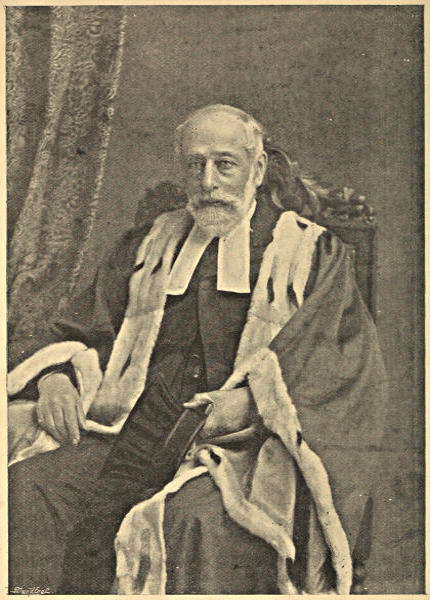The listed errata have been corrected (although the list is by nomeans comprehensive), as have obvious typos. However, the originaltext contained inconsistencies in hyphenation, accents and sometimesspelling—these have been retained.
Much of the text of this book is in old French or the Guernsey Frenchdialect, and may not conform to the expectations of a modern reader ofthe language.
GUERNSEY FOLK-LORE.

SIR EDGAR MacCULLOCH
In his Robes as Bailiff of Guernsey.
GUERNSEY FOLK-LORE
A COLLECTION OF
POPULAR SUPERSTITIONS, LEGENDARY TALES,
PECULIAR CUSTOMS, PROVERBS, WEATHER SAYINGS, ETC.,
OF THE PEOPLE OF THAT ISLAND.
FROM MSS. BY THE LATE
SIR EDGAR MacCULLOCH, Knt., F.S.A., &c.
Bailiff of Guernsey.
Edited by Edith F. Carey.
ILLUSTRATED BY NUMEROUS PHOTOGRAPHS OF OLD PRINTS, ETC.
LONDON:
ELLIOT STOCK, 62, PATERNOSTER ROW, E.C.
Guernsey: F. Clarke, States Arcade.
1903.
“LA LEGENDE, LE MYTHE, LA FABLE, SONT, COMME LA CONCENTRATIONDE LA VIE NATIONALE, COMME DES RESERVOIRS PROFONDS OU DORMENT LESANG ET LES LARMES DES PEUPLES.”—BAUDELAIRE.
AUTHOR’S PREFACE.
Of late years the ancient superstitions of the people,their legendary tales, their proverbial sayings, and,in fine, all that is designated by the comprehensiveterm of “Folk-Lore,” have attracted much anddeserved attention. Puerile as are many of thesesubjects, they become interesting when a comparisonis instituted amongst them as they exist in variouscountries. It is then seen how wide is their spread—how,for example, the same incident in a fairy tale,modified according to the manners and customs ofthe people by whom it is related, extends from theremotest east to the westernmost confines of Europe,and is even found occasionally to re-appear among thewild tribes of the American Continent, and theisolated inhabitants of Polynesia. The ethnologistmay find in this an argument for the common originof all nations, and their gradual spread from onecentral point,—the philosopher and psychologist mayspeculate on the wonderful construction of the humanmind, and, throwing aside the idea of the unity ofthe race, may attribute the similarities of traditionto an innate set of ideas, which find their expression[8]in certain definite forms,—while the historian andantiquary may sometimes discover in these populartraditions, a confirmation or explanation of somedoubtful point. Lastly, he whose sole object isamuse